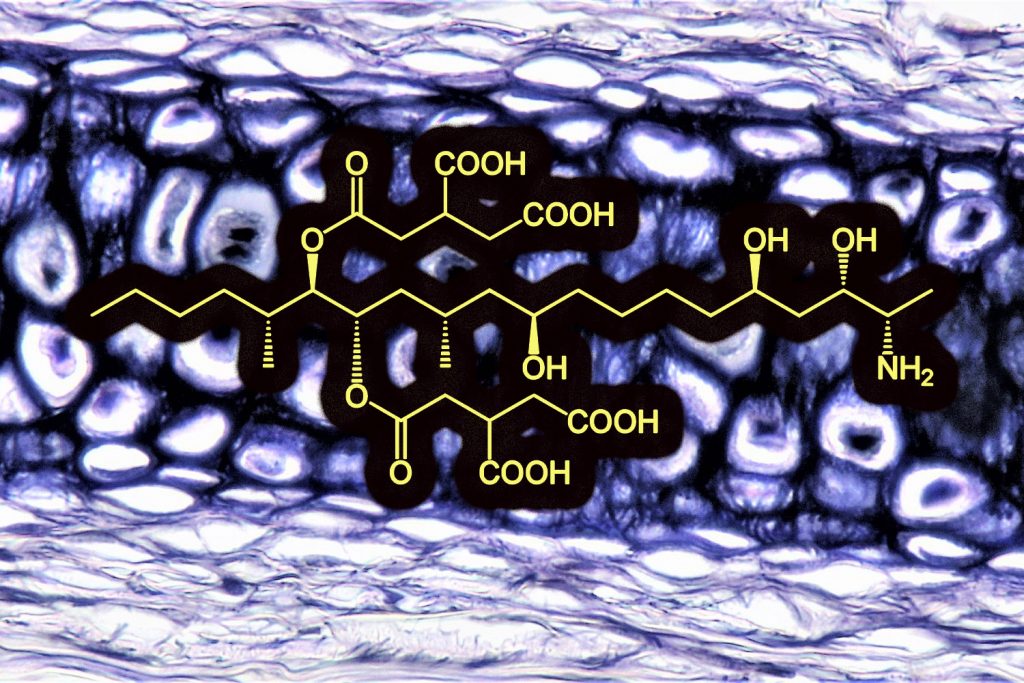11 Aug Contamination by mycotoxins and leg weakness in poultry

Leg problems are very prevalent in poultry farms and cause more economic losses than other abnormalities. It is estimated that 2-6% of all broilers show clinical signs of poor leg health, especially in the grower and finisher stages. Lame birds cannot eat and drink properly, don’t grow up to their genetic standard, and spend much more time resting on the litter, which leads to skin infections. Furthermore, at the slaughterhouse, birds with lameness are difficult to process.
Mycotoxins negatively affect bone health through the following main mechanisms of action:
- Aflatoxins, DON, T2-toxin, fumonisins reduce the absorption of calcium and vitamin D3 in the intestine.
- Mycotoxins, mainly aflatoxins, cause liver damage. As a result, vitamin D absorbed from the diet fails to convert to its biologically active form; moreover the transport of calcium and vitamin A in the blood is impaired.
- Aflatoxins and ochratoxin cause kidney damage, increasing the elimination of calcium through the urine and lowering the levels of plasmatic calcium. In laying and breeding hens, this results in an increased mobilization of calcium from the bones in order to use it in the synthesis of the eggshell. If the kidney damage persists, the hens will be affected by skeletal problems.
The bones of the legs are the most affected by the presence of mycotoxins in feed due to their big size, heavy weight, and fast growth.
Skeletal abnormalities associated to mycotoxin contamination
Rickets and layer cage fatigue
Rickets occurs in young poultry raised for meat. The most characteristic sign is poor bone mineralization. Cage layer fatigue occurs in highly productive hens. The birds are paralyzed due to the collapse of the spinal bone.
Both diseases are caused by an imbalance or a lack of calcium, phosphorus and vitamin D3. Continuous exposure to fusariotoxins (deoxynivalenol, fumonisins, T-2 and HT-2 toxins) or aflatoxins is a risk factor for rickets and layer cage fatigue.
Tibial dyschondroplasia
Tibial dyschondroplasia is an abnormality in the growth plate of the bone where the cartilage (soft) is not properly replaced by bone tissue (hard). It usually affects the tibia, leading to lameness.
It has been associated with contamination by fumonisins, fusarochromanone, a mycotoxin secreted by the mold Fusarium roseum (both at high concentrations) and T-2 toxin (at a concentration as low as 1 ppm).
Articular gout
Articular gout happens when there is a high concentration of uric acid in the plasma that leads to the precipitation of urate crystals in the joints. Such elevated concentration of uric acid is caused by kidney damage and decreased renal clearance of urates.
High concentrations of aflatoxins, ochratoxin, citrinin and oosporein are associated with articular gout.
To sum up
Improving leg health brings economic benefits and addresses animal welfare issues. Managing mycotoxin contamination should be part of a broader plan to reduce the occurrence of skeletal problems.
The best approach to manage mycotoxin risk is to implement an integrated strategy that includes good storing practices of the feedstuffs, and frequent mycotoxin analysis, as well as the regular use of a mycotoxin binder. We at PlusVet Animal Health help poultry farms to set up a mycotoxin risk management program and to evaluate the risk posed by mycotoxin in their feedstuffs.
On the other hand, whenever the diets are contaminated by mycotoxins, it is recommended to administer an extra supplement of vitamin D3 (PhytoMax©).
Productos de elección
PhytoMax© is a combination of vitamins, chelated calcium, microminerals and essential oils to be given through drinking water. It is intended for layers and breeders to:
- Maintain the levels of calcium and magnesium needed for optimal egg production.
- Reinforce skeletal health.
- Prevent cage fatigue.
- Stimulate the hepatic metabolism and the immune system.
- Improve the quality of the egg and the health of day-old chicks.
- Avoid the drop of the laying rate produced by stress (management, vaccines, hot weather, etc…)
- At the start of the laying period, to boost productivity.
- Prolong the productive life of the hen.
PlusBind© is a mixture of carefully selected silicates intended for the prevention of diseases and productivity losses related to the presence of all types of mycotoxins. It is indicated in poultry, pigs, aquaculture and ruminants.
The silicates present in PlusBind© have a highly expandable molecular structure. This characteristic gives the product a wide surface available for the adsorption of mycotoxins and therefore allows a high effectiveness at lower doses (0.5-1 kg per ton of feed).
PlusBind Bio© is a mixture of carefully selected silicates intended for the prevention of diseases and productivity losses related to the presence of all types of mycotoxins. It also contains plant extracts with prebiotic effect.
It is indicated in poultry, pigs and aquaculture.
The silicates present in PlusBind Bio© have a highly expandable molecular structure. This characteristic gives the product a wide surface available for the adsorption of mycotoxins and therefore allows a high effectiveness at lower doses (0.5-1 kg per ton of feed).
Do not miss any of our articles!
Subscribe to our monthly newsletter

Certain health statements may not be applicable in your region.

